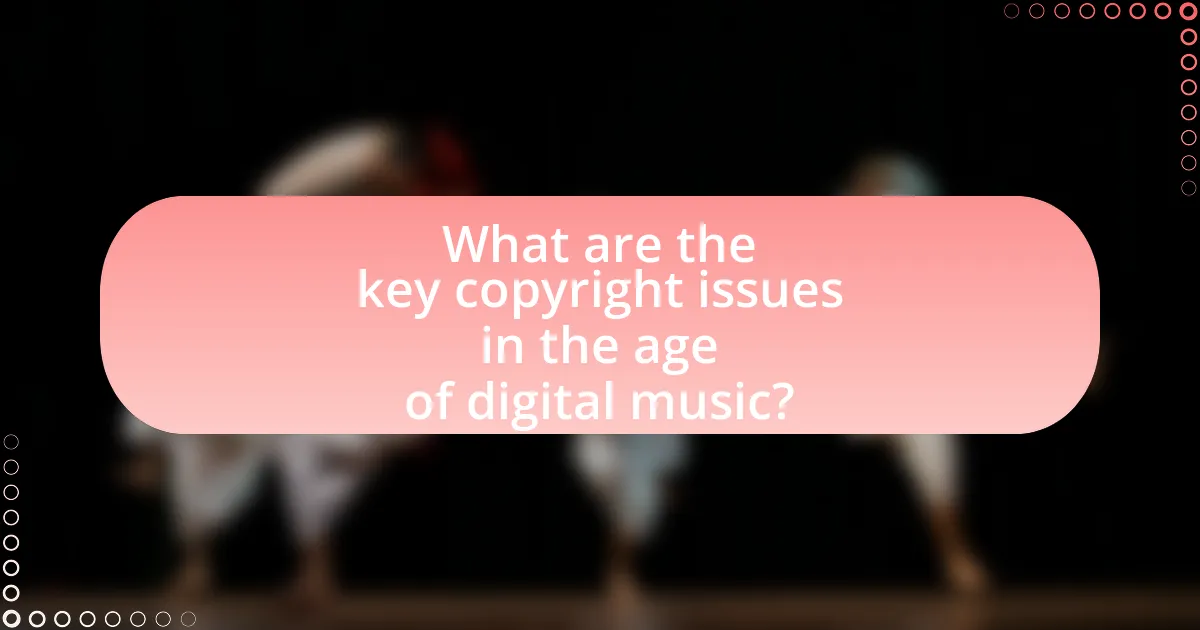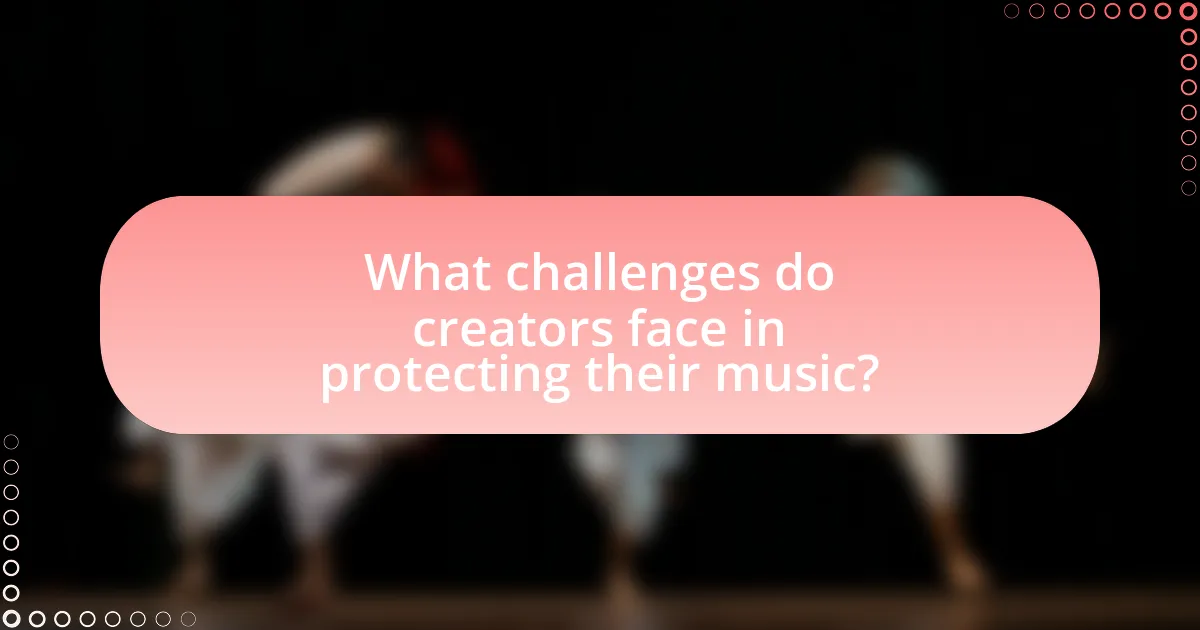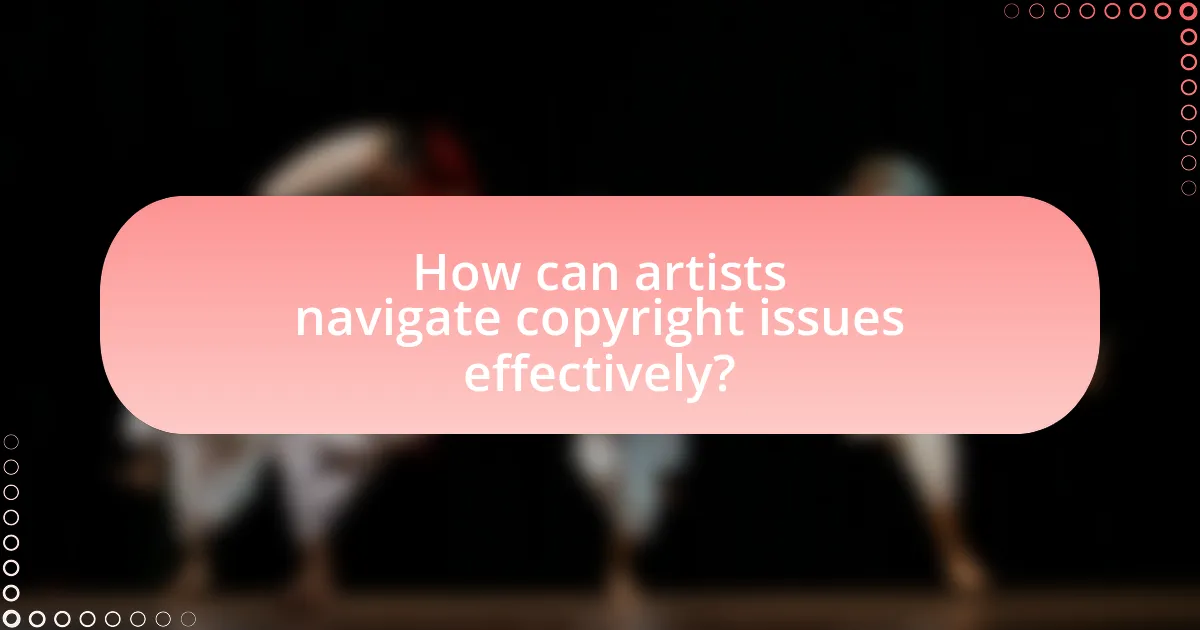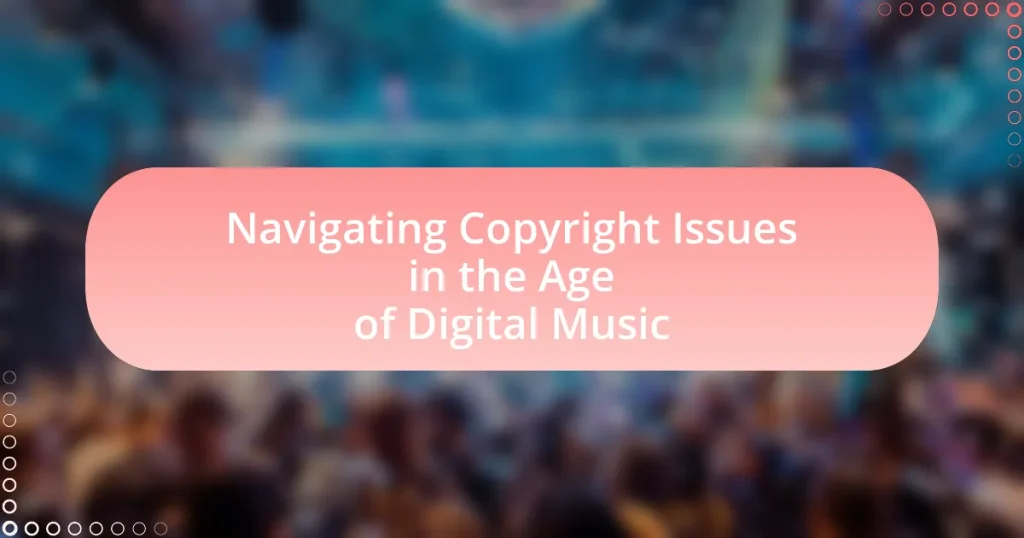The article focuses on navigating copyright issues in the age of digital music, highlighting key challenges such as unauthorized distribution, licensing complexities, and fair compensation for artists. It examines how digital music has transformed copyright landscapes, complicating enforcement and prompting calls for legal reform. The piece also discusses the implications of streaming services on copyright laws, the importance of copyright for artists, and the various rights retained by creators. Additionally, it outlines strategies for artists to protect their music rights, the role of licensing agreements, and best practices for compliance with copyright requirements in the digital environment.

What are the key copyright issues in the age of digital music?
Key copyright issues in the age of digital music include unauthorized distribution, licensing complexities, and the challenge of fair compensation for artists. Unauthorized distribution occurs when music is shared or downloaded without permission, undermining the rights of copyright holders. Licensing complexities arise from the need to navigate various rights associated with music, such as performance rights, mechanical rights, and synchronization rights, often leading to confusion and disputes. Additionally, fair compensation for artists is a significant concern, as streaming platforms typically pay lower royalties compared to traditional sales, impacting musicians’ income. According to a 2021 report by the International Federation of the Phonographic Industry, global recorded music revenues from streaming reached $23.1 billion, yet many artists struggle to earn a sustainable living from these earnings.
How has digital music changed the landscape of copyright?
Digital music has significantly altered the landscape of copyright by facilitating easier distribution and access, which has led to increased challenges in protecting intellectual property. The rise of streaming services and digital downloads has made it simpler for users to share and consume music, often without proper licensing, resulting in widespread copyright infringement. According to a 2021 report by the International Federation of the Phonographic Industry, global recorded music revenues reached $23.1 billion, highlighting the economic impact of digital music while also underscoring the ongoing struggles of artists and rights holders to enforce their copyrights in a rapidly evolving digital environment.
What are the implications of streaming services on copyright laws?
Streaming services significantly impact copyright laws by challenging traditional frameworks of intellectual property protection. These platforms often operate under licensing agreements that can complicate the enforcement of copyright, as they may not always align with existing laws designed for physical media. For instance, the Digital Millennium Copyright Act (DMCA) provides a safe harbor for platforms, allowing them to avoid liability for user-uploaded content, which can lead to disputes over ownership and fair use. Additionally, the rise of streaming has prompted calls for reform in copyright legislation to better address the realities of digital distribution, as evidenced by ongoing discussions in various jurisdictions about updating laws to reflect the needs of artists and content creators in the streaming economy.
How do digital downloads affect copyright ownership?
Digital downloads affect copyright ownership by enabling the distribution of copyrighted material without transferring ownership rights. When a user purchases a digital download, they typically receive a license to use the content rather than owning the copyright itself. This distinction is crucial, as copyright law protects the rights of creators, allowing them to control reproduction, distribution, and public performance of their work. For instance, the U.S. Copyright Act of 1976 establishes that copyright ownership remains with the creator unless explicitly transferred, which is often not the case with digital downloads. Therefore, while consumers gain access to the content, the original copyright holder retains ownership and associated rights.
Why is copyright important for artists and creators?
Copyright is important for artists and creators because it protects their original works from unauthorized use and ensures they receive recognition and financial compensation for their creations. This legal protection allows artists to control how their work is distributed and used, preventing others from exploiting their intellectual property without permission. According to the U.S. Copyright Office, copyright grants creators exclusive rights to reproduce, distribute, and display their works, which is essential in the digital age where content can be easily copied and shared online. This framework not only incentivizes creativity by providing economic benefits but also fosters a culture of respect for intellectual property, crucial for the sustainability of artistic industries.
What rights do artists retain under copyright law?
Artists retain several key rights under copyright law, primarily including the right to reproduce their work, the right to distribute copies, the right to perform or display their work publicly, and the right to create derivative works. These rights are established under the Copyright Act of 1976 in the United States, which grants creators exclusive control over their original works for a duration of the creator’s life plus 70 years. This legal framework ensures that artists can protect their intellectual property and receive compensation for its use, thereby incentivizing creativity and innovation in the digital music landscape.
How does copyright protection impact an artist’s revenue?
Copyright protection significantly enhances an artist’s revenue by granting exclusive rights to their creative works, allowing them to control distribution and usage. This exclusivity enables artists to monetize their music through sales, licensing, and royalties, which are crucial for their financial sustainability. For instance, according to the U.S. Copyright Office, artists can earn substantial income from licensing their music for use in films, commercials, and streaming platforms, with the global music industry generating over $20 billion in revenue in 2020, largely attributed to copyright protections. Thus, effective copyright laws directly correlate with increased revenue opportunities for artists.

What challenges do creators face in protecting their music?
Creators face significant challenges in protecting their music, primarily due to the complexities of copyright laws and the ease of digital distribution. The rapid proliferation of online platforms allows for widespread sharing and potential infringement, making it difficult for artists to monitor unauthorized use of their work. Additionally, the lack of uniformity in copyright laws across different countries complicates enforcement efforts, as creators may struggle to assert their rights internationally. According to a 2021 report by the International Confederation of Music Publishers, over 70% of music creators reported difficulties in enforcing their rights, highlighting the pervasive nature of these challenges in the digital age.
How do unauthorized uses of music occur in the digital space?
Unauthorized uses of music in the digital space occur primarily through illegal downloads, unauthorized streaming, and the sharing of copyrighted material on social media platforms. These actions violate copyright laws, as they distribute music without the permission of the copyright holder. For instance, a 2020 study by the International Federation of the Phonographic Industry reported that 20% of internet users globally admitted to using illegal streaming services, highlighting the prevalence of unauthorized access to music. Additionally, platforms like YouTube and TikTok often host user-generated content that incorporates copyrighted music without proper licensing, further contributing to unauthorized uses.
What are the common forms of copyright infringement in digital music?
Common forms of copyright infringement in digital music include unauthorized reproduction, distribution, and public performance of copyrighted works. Unauthorized reproduction occurs when individuals or entities copy music files without permission from the copyright holder, often seen in file-sharing platforms. Distribution infringement happens when music is shared or sold without authorization, such as uploading songs to streaming services without rights. Public performance infringement involves playing copyrighted music in public spaces without obtaining the necessary licenses, which is a violation of copyright law. These actions violate the rights of copyright owners and can lead to legal consequences.
How can creators identify and address unauthorized use of their work?
Creators can identify unauthorized use of their work by utilizing digital monitoring tools and conducting regular searches for their content online. These tools, such as Google Alerts and reverse image search engines, help track instances where their work appears without permission. To address unauthorized use, creators should document the infringement, contact the infringing party with a cease-and-desist letter, and, if necessary, pursue legal action to enforce their rights. According to the U.S. Copyright Office, creators have the right to take legal action against unauthorized use, reinforcing the importance of protecting their intellectual property.
What role do licensing agreements play in copyright protection?
Licensing agreements are essential in copyright protection as they legally authorize the use of copyrighted material while ensuring that the rights of the copyright holder are respected. These agreements specify the terms under which a user can utilize the copyrighted work, including the scope of use, duration, and compensation. For instance, in the music industry, licensing agreements allow artists and producers to grant permission for their songs to be used in films, commercials, or streaming services, thereby generating revenue and protecting their intellectual property rights. By formalizing the relationship between copyright holders and users, licensing agreements help prevent unauthorized use and infringement, which is crucial in the digital age where content can be easily shared and reproduced.
What types of licenses are available for digital music distribution?
The types of licenses available for digital music distribution include mechanical licenses, synchronization licenses, performance licenses, and master use licenses. Mechanical licenses allow the reproduction of a musical composition in a digital format, typically required for streaming services and downloads. Synchronization licenses are necessary for pairing music with visual media, such as films or advertisements. Performance licenses are needed for public performances of music, including online streaming platforms. Master use licenses grant permission to use a specific recording of a song, often required when a particular version of a track is used in media. Each license serves a distinct purpose in ensuring that copyright holders are compensated for the use of their music in the digital landscape.
How can artists negotiate favorable licensing terms?
Artists can negotiate favorable licensing terms by clearly understanding their rights and the value of their work. They should conduct thorough research on industry standards and comparable licensing agreements to establish a strong negotiating position. Additionally, artists can leverage their unique brand and audience engagement metrics to justify higher compensation or more favorable terms. For instance, a study by the Music Industry Research Association highlights that artists who present data on their streaming numbers and social media following often secure better deals. By being well-prepared and informed, artists can effectively advocate for terms that reflect their contributions and market value.

How can artists navigate copyright issues effectively?
Artists can navigate copyright issues effectively by understanding copyright laws, registering their works, and utilizing licensing agreements. Knowledge of copyright laws, such as the Berne Convention, which protects original works automatically upon creation, empowers artists to assert their rights. Registering works with the U.S. Copyright Office provides legal advantages, including the ability to sue for statutory damages. Additionally, artists can use licensing agreements to grant permission for others to use their work while retaining ownership, ensuring they receive compensation and control over their creations. These strategies collectively help artists protect their intellectual property in the digital music landscape.
What strategies can artists employ to protect their music rights?
Artists can employ several strategies to protect their music rights, including registering their works with copyright offices, utilizing digital rights management (DRM) technologies, and joining performance rights organizations (PROs). Registering music with copyright offices provides legal recognition and the ability to enforce rights in case of infringement. DRM technologies help control the distribution and usage of digital music, preventing unauthorized copying and sharing. Joining PROs allows artists to collect royalties for public performances and ensure their rights are managed effectively. These strategies are essential for safeguarding intellectual property in the evolving digital landscape.
How can artists leverage technology to monitor copyright infringement?
Artists can leverage technology to monitor copyright infringement by utilizing digital fingerprinting and content identification systems. These technologies, such as YouTube’s Content ID and services like TuneCore and Audiam, analyze audio and video files to detect unauthorized use of copyrighted material. For instance, a study by the International Federation of the Phonographic Industry (IFPI) reported that digital fingerprinting can identify over 90% of unauthorized content on platforms, enabling artists to take action against infringement effectively. Additionally, blockchain technology offers a transparent way to track ownership and usage rights, further empowering artists to monitor and protect their work in the digital landscape.
What resources are available for artists seeking legal advice on copyright?
Artists seeking legal advice on copyright can access several resources, including legal clinics, professional organizations, and online platforms. Legal clinics, often affiliated with universities, provide free or low-cost legal assistance to artists. Professional organizations such as the American Bar Association and the Copyright Society of the USA offer resources, networking opportunities, and referrals to copyright attorneys. Additionally, online platforms like LegalZoom and Rocket Lawyer provide accessible legal information and services tailored for artists. These resources are essential for navigating copyright issues effectively in the digital music landscape.
What best practices should artists follow in the digital music landscape?
Artists should prioritize copyright awareness and digital distribution strategies in the digital music landscape. Understanding copyright laws is essential for protecting original works and ensuring proper licensing when using samples or covers. Additionally, artists should utilize digital platforms effectively by distributing music through reputable streaming services and engaging with audiences on social media to build a fanbase. According to the International Federation of the Phonographic Industry (IFPI), 70% of music consumption now occurs through streaming, highlighting the importance of digital presence. Furthermore, artists should consider using digital rights management (DRM) tools to safeguard their music from unauthorized use, ensuring they retain control over their intellectual property.
How can artists educate themselves about copyright laws and regulations?
Artists can educate themselves about copyright laws and regulations by accessing resources such as online courses, legal workshops, and government websites dedicated to intellectual property. For instance, the U.S. Copyright Office provides comprehensive information on copyright laws, including registration processes and rights associated with creative works. Additionally, organizations like the American Bar Association offer seminars and publications that cover copyright issues relevant to artists. Engaging with these resources allows artists to understand their rights and obligations, ensuring they navigate the complexities of copyright effectively.
What steps can artists take to ensure compliance with copyright requirements?
Artists can ensure compliance with copyright requirements by registering their works with the U.S. Copyright Office, which provides legal protection and establishes a public record of ownership. Additionally, artists should familiarize themselves with copyright laws, including fair use provisions, to understand how their work can be used by others. They must also obtain licenses for any third-party content they wish to incorporate into their creations, ensuring that they have permission to use copyrighted material. Furthermore, artists should keep detailed records of their creative process and any agreements made regarding their work, as this documentation can be crucial in case of disputes. These steps are essential for protecting their rights and avoiding legal issues in the digital music landscape.
What are the common pitfalls to avoid in copyright management?
Common pitfalls to avoid in copyright management include failing to properly register works, neglecting to monitor usage, and misunderstanding fair use. Proper registration is crucial because unregistered works may not receive the full protection of copyright law, making enforcement difficult. Monitoring usage is essential to ensure that rights are not infringed upon, as unauthorized use can lead to financial losses. Misunderstanding fair use can result in legal disputes; for instance, using copyrighted material without permission under the assumption that it qualifies as fair use can lead to significant penalties. These pitfalls can undermine the effectiveness of copyright management and expose creators to legal risks.
How can artists prevent unintentional copyright violations?
Artists can prevent unintentional copyright violations by conducting thorough research on the ownership and licensing of any material they use in their work. This includes verifying the copyright status of samples, images, and other creative elements before incorporating them into their projects. According to the U.S. Copyright Office, using copyrighted material without permission can lead to legal repercussions, emphasizing the importance of understanding copyright laws. Additionally, artists should consider utilizing royalty-free resources or obtaining licenses for any third-party content, which can further safeguard against potential infringements.
What mistakes should artists avoid when dealing with digital music platforms?
Artists should avoid the mistake of neglecting to read and understand the terms and conditions of digital music platforms. Many artists fail to recognize that these agreements often contain clauses that can significantly impact their rights, such as ownership of the music, revenue sharing, and distribution rights. For instance, a survey by the Music Industry Research Association found that 70% of independent artists do not fully understand the licensing agreements they sign, which can lead to unintentional forfeiture of rights or revenue. Additionally, artists should not overlook the importance of properly registering their music with copyright offices and digital distribution services to protect their intellectual property. This oversight can result in unauthorized use of their work and loss of potential income.


